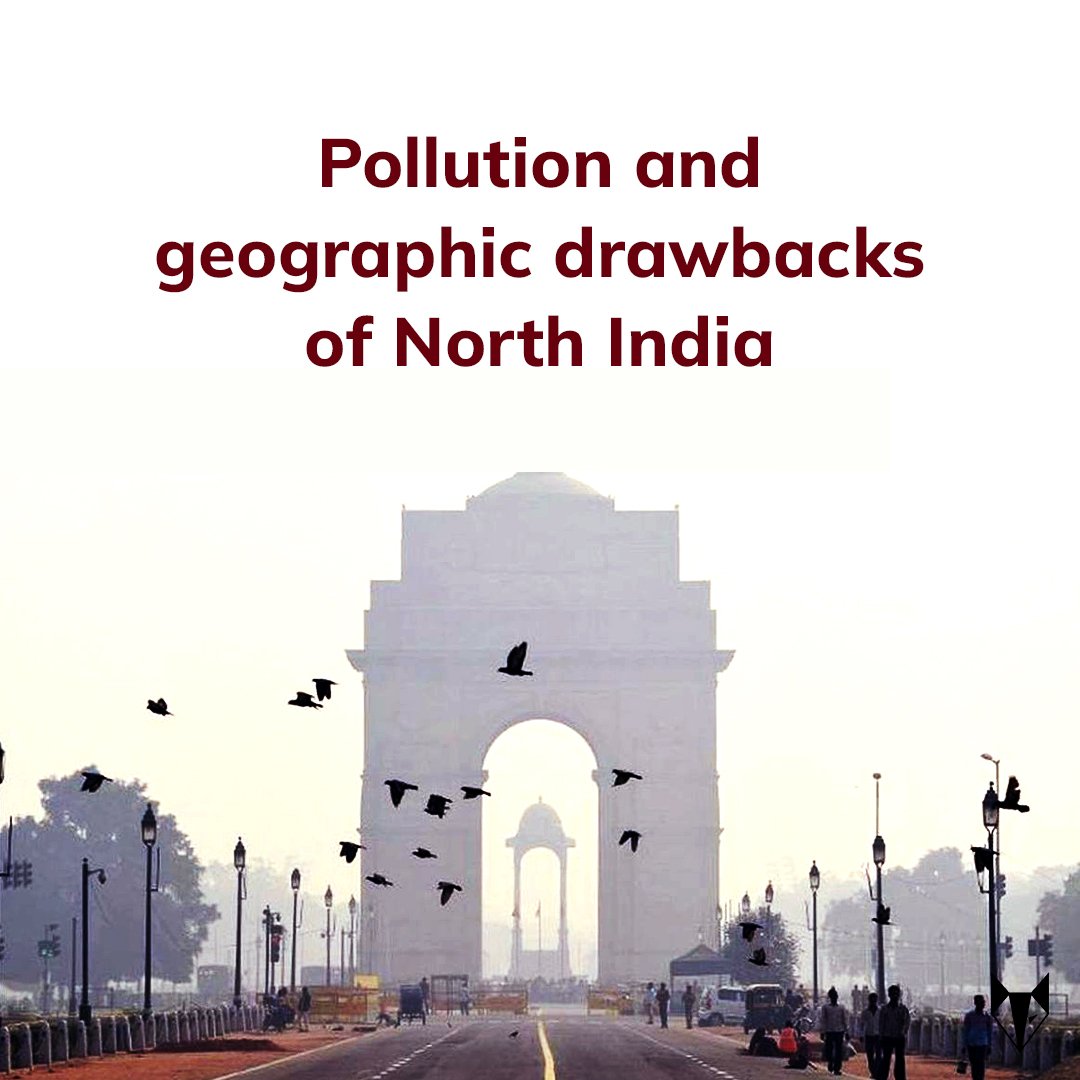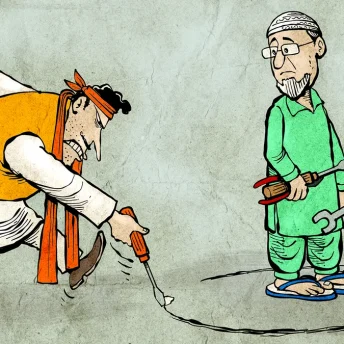Listen on Spotify & Apple Podcast
North India’s air pollution continues to be a pressing problem despite several government initiatives to mitigate the issue. Experts have noted that the health impact of simply breathing is equivalent to smoking a pack of cigarettes every day. In the winters from October to January, authorities in Delhi floats health advisories asking people to remain indoors and avoid exercising as the city turns into a ‘gas chamber’. Why are Delhi and the northern region of India becoming the epicentre of pollution? Is geography a contributing factor?
Silently, air pollution claims the lives of over a million Indians each year. Hospitalizations, grave illnesses, and financial difficulties place families in a never-ending cycle that hinders their ability to be productive and contribute to the economy. It has been demonstrated that children born in areas with high levels of air pollution have permanently decreased cognitive and lung function, which will have an impact on their productivity for years to come. They all endure pain in silence.
Annual average pollutant concentrations in cities in 2019. Source
A 2022 list by IQ Air of the world’s most polluted cities shows 14 of the top 20 most polluted cities are in India – Bhiwandi, Ghaziabad, Delhi, Jaunpur, Noida, Bagpat, Hisar, Faridabad, Greater Noida, Rohtak, Lucknow, Jind, Gurugram and Kanpur.
And most of these cities are in North India. Although mainly the pollution in Delhi remains in the news, it’s the same reality in across North India
Map of top 35 polluted Indian cities in 2022 worlds top 50 polluted cities. Data Source
The issue is more intricate than previously thought. The hazardous brew comes from a startling array of sources, including the burning of agricultural waste and garbage, as well as the combustion of dung and other fuels for cooking and heating, in addition to big polluters like vehicles and coal-fired power stations.
The question that follows is: Why is the northern region of India becoming the epicenter of pollution?
Disadvantages in the location itself
“Because of geographic disadvantages, air pollution in the city would never be reduced to acceptable levels”.
The wind speed, direction, and lack of moisture are the most important factors influencing air quality.
The average wind speed in Delhi during the winter months ranges from 1-3 meters per second, which is significantly lower than the average wind speed in the rest of the country. The pollution is also due to the lack of wind which may drive pollutants away.
The most part of the year air in North India is dry, as it is relatively far from the coastal areas. The moist air or sea breeze from the Indian ocean, Arabian sea, and the Bay of Bengal, gets drier as it moves north. And the dry winds carry more and more dust. This becomes bad by winter in Nov to January, which causes pollutants to settle low above the ground and reduce visibility.
Although winds from the sea of the Bay of Bengal operate as a constant “reset” button for Delhi’s air quality, pollution levels remain severe to a large degree owing to the geographic and climatic circumstances.
To make things worse, the Thar Desert to the northwest of India, the central plains, and the Himalayas to the north surround north India. Dust and suspended particles are multiplied due to sandstorms from the nearby Thar desert in Rajasthan. This is already causing deforestation in the highlands around Delhi – NCR.
As the winds blow in from the coastal areas towards the north, carrying pollutants with them to the northern plains, they eventually get trapped by the Himalayas in the North.
That is the geographical tragedy of Delhi and northern India.
Subtle Burning – Forest Fires – Industrial Air Pollution
The practice of stubble burning to clear the farmland for the next harvest is prevalent in farming in the states of Punjab, Haryana, and western Uttar Pradesh.
The seasonal stubble burning which happens in the months of Oct – November produces smoke that lingers throughout the winter. Forest fires in Himachal and Uttarakhand, burning leaves, cooking and heating stoves also contribute to the smog.
Thermal power plants within 300 km of Delhi
The winds also carry sulfur dioxide generated by big power plants and refineries for the 13 fossil-fuel-powered power plants within a 300-kilometer radius of Delhi.
Thermal power plants within 300 kms of Delhi. Source
Stubble burning in the last week of October 2018 in Punjab (Source: NASA EOSDIS Worldview)
This confinement and build-up harm not only Delhi, but the entire region from Punjab to West Bengal. This is like a “bowl” that accumulates pollutants and has just a restricted exit for them to escape.
Pollution added by emissions from factories, coal-fired power stations, brick kilns, and transport contribute to winter smog and hazardous mist.
Dreadful winter smog of Delhi
Winter Smog of Delhi [courtesy- @thehindustantimes]
In essence, the Northern plain is enclosed by land. Senior researcher at IIT-Kanpur Sachchidananda Tripathi claims that the Himalayas prevent polluted air from fleeing out of the Himalayan ranges to further north, which is why pollutant-heavy air does not move out of the northern region of India.
In winters this mix of polluted air settles close to the ground level, because hot air is lighter and rises above, but cool air is heavier. Since the cooler winter air is unable to rise above the high mountain range, it is eventually trapped within the plains.
Indo-Gangetic plain landlocking pollution Source: Scroll.in
In winters when moisture droplets rest on suspended particles, they react with gases to produce the muddy-brown haze that has come to be associated with winter in Delhi. This is how the dreaded winter smog is created.
How do Southern India’s towns have cleaner air than their northern counterparts?
Southern cities are not that worse even if many causes of air pollution remain in the region.
But the situation in South India and coastal areas is different. Let’s consider the large city of Chennai the capital of Tamil Nadu. Chennai and its surrounding districts are India’s automotive capital, with some of the world’s largest manufacturers. Tamil Nadu has several coal-fired power plants, and Chennai has one of the largest numbers of vehicle densities. If you’ve never been to Chennai, you’d think it’s a deep grey soup of pollution fed by the chimneys and tailpipes of over 500,000 cars, buses, and trucks, much like Delhi during the winter smog. But that’s not the case.
People of this mega-city have inhaled air with mild amounts of pollutants and are free of pollution compared to Delhi and northern India. Because it is a coastal city, the wind takes most of the pollution away from it.
“The lack of winds that can carry away pollutants is one of the most important factors impacting air quality.”
Delhi-NCR should be treated as a sensitive pollution zone
Owing to its ‘metrological misfortune’, Delhi, and most cities of Northern India for that matter, can’t be treated with the same environmental policy. For a place with so many location disadvantages and a massive population, special provisions and mandates should be ensured to combat pollution. Every ecosystem is different in its adaptability to change.
Delhi’s pollution cries can be heard across the news media in the winter, and government failure to combat is highlighted, sometimes for political reasons. But the situation is not dire only in Delhi but across north India.
Delhi is bordering 2 States Uttar Pradesh and Haryana, and 4 major cities, Gurgaon, Faridabad, Noida (Gautam Buddha Nagar), and Ghaziabad. Gurgaon (now Gurugram) and Faridabad are in Haryana. Ghaziabad and Noida are in Uttar Pradesh. These 5 cities are collectively known as Delhi-National Capital Region (Delhi- NCR). And all the areas in and nearby NCR have major industries in operation.
However, the media portrays that only Delhi isn’t doing enough to combat the pollution problem. The point is that only one alone state can’t fix this pollution problem in north India as a whole.
Map of Delhi – National Capital Region (NCR)
The governments of the three states of Delhi, Haryana, and Uttar Pradesh would have to come together to formulate a strategic solution. Rather, a national policy is required to implement these solutions across all the affected North Indian states.
The politics between the center and state governments don’t help much. It only gives way to blame the game and bad policy implementation.
The idea of sustainability could be the same across the board, but its implementation should be different as per the sensitivity of the environment of a place. And North India, and especially Delhi-NCR needs a different strategy altogether.
It’s high time common people who are most impacted by the pollution crisis should raise demand for a holistic solution from the policymakers. And not just get swayed by the biased news coverage and political blame game.
Until common people demand, the ones in power won’t act. Or only act enough so that the people remain silent.
#CuriousTitans #PollutionCrisisOfNorthIndia #WinterSmog












